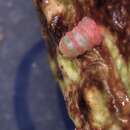Life Cycle
(
englanti
)
tarjonnut EOL authors
In the spring, Tegeticula spp. emerge from cocoons and fly to nearby yucca plants and mate. The female then deposits eggs into the yucca plant ovary and deposits a pollen ball on the flower's stigma, pollinating the plant. The larva, usually one or two, hatch inside the developing ovary during late spring and summer and feed on the maturing seeds through the summer and fall. The larva bores out of the fruit upon maturity and creates a cocoon in the soil. The adult then emerges up to one year later.
- lisenssi
- cc-publicdomain
- tekijänoikeus
- National Biological Information Infrastructure (NBII) at http://www.nbii.gov
Pollinator
(
englanti
)
tarjonnut EOL authors
The relationship between the yucca moth (Genus: Tegeticula) and yucca plant (Genus: Yucca) is believed to have begun at least 40 million years ago and is one of the most cited examples of co-evolution. The yucca plant requires pollination by the yucca moth and moth larvae, in turn, require developing yucca seeds for food - a relationship known as an obligate mutualism. This is actually one of the few documented cases of active pollination because the moth purposefully places pollen on the plants' stigmas. The female yucca moth has specially adapted mouth-parts used for pollen handling. The moth drags its tentacles across the yucca's anthers and collects a large amount of pollen, which the moth then forms into a sticky ball and carries it between its tentacles and thorax. This pollen ball is very large - often made of nearly 10,000 grains of pollen - and can constitute up to 10% of the moth's weight. After collecting the pollen ball, the moth flies to a different yucca plant to deposit its eggs. The moth deposits its eggs in the flower's ovary and uses its tentacles to scrape the pollen ball onto the top of the yucca plant's stigma, pollinating the yucca plant. The moth then climbs to the new flower's anthers and collects pollen, and repeats the entire process.
- lisenssi
- cc-publicdomain
- tekijänoikeus
- National Biological Information Infrastructure (NBII) at http://www.nbii.gov
Tegeticula: Brief Summary
(
englanti
)
tarjonnut wikipedia EN
Tegeticula is a genus of moths of the family Prodoxidae, one of three genera known as yucca moths; they are mutualistic pollinators of various Yucca and Hesperoyucca species.
- lisenssi
- cc-by-sa-3.0
- tekijänoikeus
- Wikipedia authors and editors

